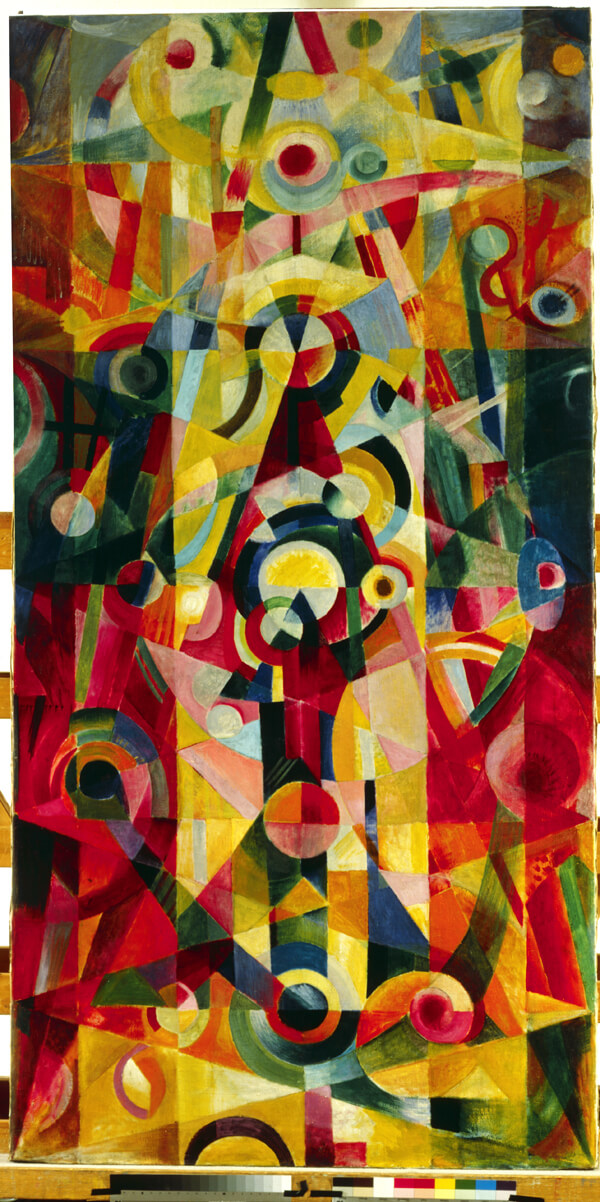Ascent and Pause
Ascent and Pause, composed in 2003, was commissioned by Mario Brunello, ‘cellist and leader of the Orchestra d’Archi Italiana, for the Milan concert series “Note depinte” (Painted Notes).

Markus Stockhausen, as a guest musician, was asked to write a piece in which an extra-musical subject should serve as source of inspiration. He chose the picture “Ascent and Pause” by the Swiss painter, art theoretician and Kandinsky-student Johannes Itten. This is a long, upright painting with crossing diagonal lines broken by segments of circles. The geometric surfaces are filled out with strong, richly contrasting colours. The mixture of clear structure and spontaneous energy immediately interested Markus Stockhausen, so “Ascent and Pause” became the program for his own work, in which clearly outlined structures and free improvisation merge together. Markus Stockhausen wrote the piece for flugelhorn (doubling trumpet and piccolo trumpet) and string orchestra, with himself as the soloist and his own fingers in mind. It was premiered in January 2004 with the Orchestra d’Archi Italiana.
In accordance with the title, the piece has two parts: a lively “Ascent” followed by a composed “Pause”. The flugelhorn begins with an ascending motive over generously constructed string surfaces and a first improvisation – in tense anticipation of the actual ascent. This begins with swift movements in the strings, whose canonical entries fleetingly remind one of baroque sound worlds. For Markus Stockhausen, this is a homage to Johann Sebastian Bach, whose keyboard music and 2nd Brandenburg Concerto have been with him as a soloist for a long time. Flowing quintuplets and septuplets give the music a floating ease. This is a stylistic tool which Markus Stockhausen remembers from his time playing with Rainer Brüninghaus: “It was the beginning of the 80s. Brüninghaus wrote many compositions in seven. Seven somehow makes the music float. It pushes the music forward.” Here, the trumpet rises to a free improvisation over springy arpeggiated chords in the second violins and violas, and driving syncopations in the celli and double-basses.
The piece then enters the jazz sphere with the soft sound of a harmon-mute. Even if this sound is unmistakably connected with Miles Davis, it has long been part of Markus Stockhausen’s own tonal language when it comes to “communicating something distant, far away”. Composed and improvised moments alternate repeatedly until this lively section is abruptly broken off by a short fortissimo tutti-riff. The sound sinks back to pianissimo. All motion ceases, all feeling for time dissolves. Instead of moving septuplets, a single deep breath over stationary sound surfaces: “Pause”. At this point, the soloist is instructed to: “Improvise very carefully, at first just very few notes, leaving long pauses, play in harmony with the strings.” Towards the end, a change from the warm-toned flugelhorn to radiant piccolo trumpet brightens the atmosphere once again. Shortly before the final chord, the composer invites the first player in each string section to: “Gently improvise melodies in F-Lydian.” A last flowering – or as Markus Stockhausen calls it: A moment of joy.
Text by Markus Stockhausen and Sylvia Systermanns, tranlated by James Ingram

Instruments:
Solo Flugelhorn / Trumpet / Piccolo Trumpet
String Orchestra
Comissioned by Maria Brunello and the Orchestra d’Archi Italiana
Premiered on January 17th, 2004 in Rome, Italy
Aktivraum Musikverlag, Köln 2003
ISMN : M-700233-10-5





